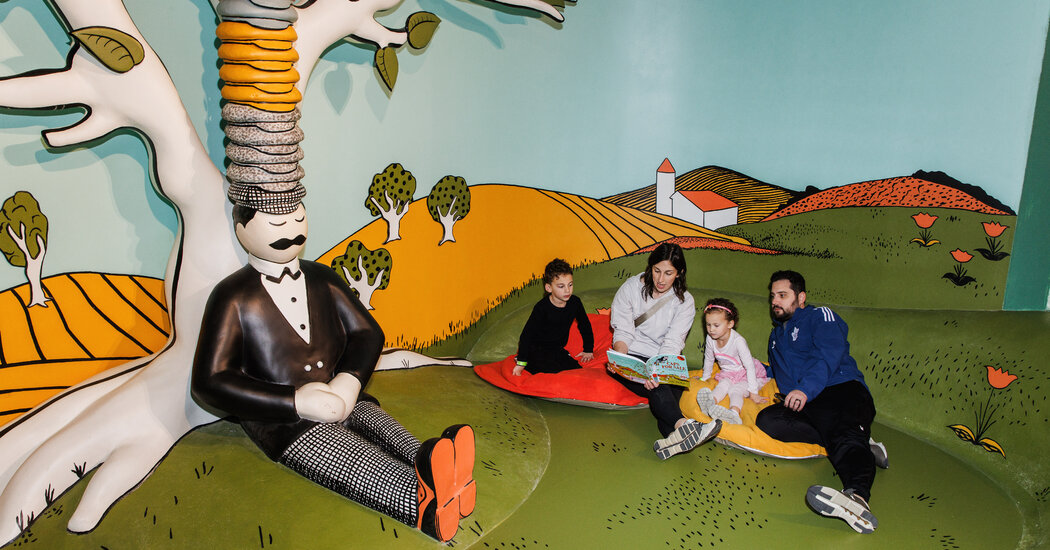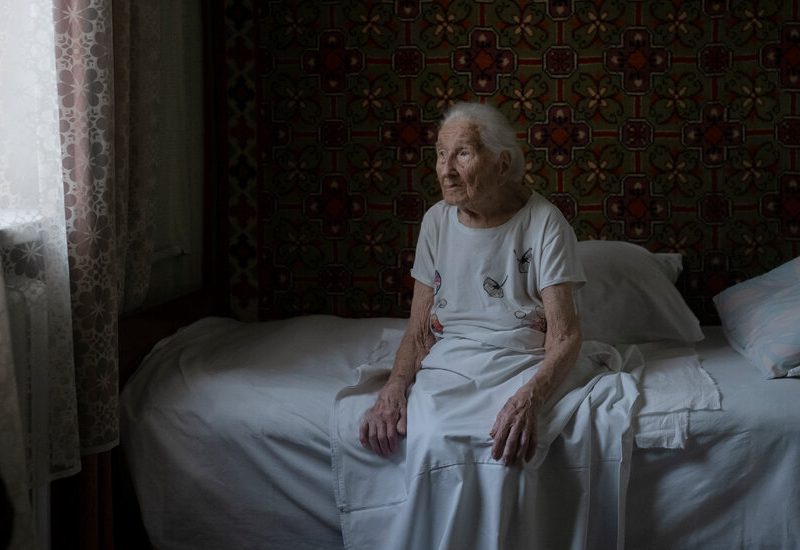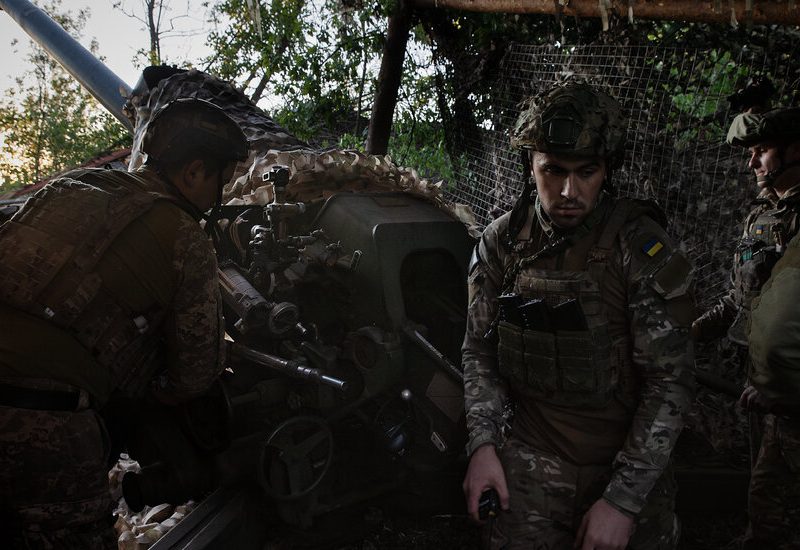On a crisp Saturday morning that screamed for adventure, a former tin can factory in North Kansas City, Mo. thrummed with the sound of young people climbing, sliding, spinning, jumping, exploring and reading.
Yes, reading.
If you think this is a silent activity, you haven’t spent time in a first grade classroom. And if you think all indoor destinations for young people are sticky, smelly, depressing hellholes, check your assumptions at the unmarked front door.
Welcome to the Rabbit Hole, a brand-new, decade-in-the-making museum of children’s literature founded by the only people with the stamina for such a feat: former bookstore owners. Pete Cowdin and Deb Pettid are long-married artists who share the bullish determination of the Little Red Hen. They’ve transformed the hulking old building into a series of settings lifted straight from the pages of beloved picture books.
Before we get into what the Rabbit Hole is, here’s what it isn’t: a place with touch screens, a ball pit, inscrutable plaques, velvet ropes, a cloying soundtrack or adults in costumes. It doesn’t smell like graham crackers, apple juice or worse (yet). At $16 per person over two years old, it also isn’t cheap.
During opening weekend on March 16, the museum was a hive of freckles and gap toothed grins, with visitors ranging in age from newborn to well seasoned. Cries of “Look up here!,” “There’s a path we need to take!” and “There’s Good Dog Carl!” created a pleasant pandemonium. For every child galloping into the 30,000 square foot space, there was an adult hellbent on documenting the moment.
Did you ever have to make a shoe box diorama about your a favorite book? If so, you might remember classmates who constructed move-in ready mini kingdoms kitted out with gingham curtains, clothespin people and actual pieces of spaghetti.
Cowdin, Pettid and their team are those students, all grown up.
The main floor of the Rabbit Hole consists of 40 book-themed dioramas blown up to life-size and arranged, Ikea showroom-style, in a space the size of two hockey rinks. The one inspired by John Steptoe’s “Uptown” features a pressed tin ceiling, a faux stained-glass window and a jukebox. In the great green room from “Goodnight Moon,” you can pick up an old-fashioned phone and hear the illustrator’s son reading the story.
One fictional world blends into the next, allowing characters to rub shoulders in real life just as they do on a shelf. Visitors slid down the pole in “The Fire Cat,” slithered into the gullet of the boa constrictor in “Where the Sidewalk Ends” and lounged in a faux bubble bath in “Harry the Dirty Dog.” There are plenty of familiar faces — Madeline, Strega Nona, Babar — but just as many areas dedicated to worthy titles that don’t feature household names, including “Crow Boy,” “Sam and the Tigers,” “Gladiola Garden” and “The Zabajaba Jungle.”
Emma Miller, a first-grade teacher, said, “So many of these are books I use in my classroom. It’s immersive and beautiful. I’m overwhelmed.”
As her toddler bolted toward “Frog and Toad,” Taylar Brown said, “We love opportunities to explore different sensory things for Mason. He has autism so this is a perfect place for him to find little hiding holes.”
A gaggle of boys reclined on a bean bag in “Caps for Sale,” passing around a copy of the book. Identical twins sounded out “Bread and Jam for Frances” on the pink rug in the badger’s house. A 3-year-old visiting for the second time listened to her grandfather reading “The Tawny Scrawny Lion.”
Tomy Tran, a father of three from Oklahoma, said, “I’ve been to some of these indoor places and it’s more like a jungle gym. Here, my kids will go into the area, pick up the book and actually start reading it as if they’re in the story.”
All the titles scattered around the museum are available for purchase at the Lucky Rabbit, a bookstore arranged around a cozy amphitheater. Pettid and Cowdin estimate that they’ve sold one book per visitor, with around 650 guests per day following the pink bunny tracks from the parking lot.
Once upon a time, Cowdin and Pettid owned the Reading Reptile, a Kansas City institution known not just for its children’s books but also for its literary installations. When Dav Pilkey came to town, Pettid and Cowdin welcomed him by making a three-and-a-half foot papier-mâché Captain Underpants. Young customers pitched in to build Tooth-Gnasher Superflash or the bread airplane from “Mickey in the Night Kitchen.”
One of the store’s devotees was Meg McMath, who continued to visit through college, long after she’d outgrown its offerings (and its chairs). Now 36, McMath traveled from Austin, Texas with her husband and six-month-old son to see the Rabbit Hole. “I’ve cried a few times,” she said.
The Reading Reptile weathered Barnes & Noble superstores and Amazon. Then came “the Harry Potter effect,” Pettid said, “where all of a sudden adults wanted kids to go from picture books to thick chapter books. They skipped from here to there; there was so much they were missing.”
As parents fell under the sway of reading lists for “gifted” kids, story time became yet another proving ground.
“It totally deformed the reading experience,” Cowdin said. Not to mention the scourge of every bookstore: surreptitious photo-snappers who later shopped online.
In 2016, Cowdin and Pettid closed the Reptile to focus on the Rabbit Hole, an idea they’d been percolating for years. They hoped it would be a way to spread the organic bookworm spirit they’d instilled in their five children while dialing up representation for readers who had trouble finding characters who looked like them. The museum would celebrate classics, forgotten gems and quality newcomers. How hard could it be?
Cowdin and Pettid had no experience in the nonprofit world. They knew nothing about fund-raising or construction. They’re ideas people, glass half full types, idealists but also stubborn visionaries. They didn’t want to hand their “dream” — a word they say in quotes — to consultants who knew little about children’s books. Along the way, board members resigned. Their kids grew up. Covid descended. A tree fell on their house and they had to live elsewhere for a year. “I literally have told Pete I quit 20 times,” Pettid said.
“It has not always been pleasant,” Cowdin said. “But it was just like, OK, we’re going to do this and then we’re going to figure out how to do it. And then we just kept figuring it out.”
Little by little, chugging along like “The Little Engine That Could,” they raised $15 million and assembled a board who embraced their vision and commitment to Kansas City. They made a wish list of books — “Every ethnicity. Every gender. Every publisher,” Pettid said — and met with rights departments and authors’ estates about acquiring permissions. Most were receptive; some weren’t. (They now have rights to more than 70 titles.)
“A lot of people think a children’s bookstore is very cute,” Pettid said. “They have a small mind for children’s culture. That’s why we had to buy this building.”
For $2 million, they bought the factory from Robert Riccardi, an architect whose family operated a beverage distribution business there for two decades. His firm, Multistudio, worked with Cowdin and Pettid to reimagine the space, which sits on an industrial corner bordered by train tracks, highways and skyline views.
Cowdin and Pettid started experimenting with layouts. Eventually they hired 39 staff members, including 21 full-time artists and fabricators who made everything in the museum from some combination of steel, wood, foam, concrete and papier-mâché.
“My parents are movers and shakers,” Gloria Cowdin said. She’s the middle of the five siblings, named after Frances the badger’s sister — and, yes, that’s her voice reading inside the exhibit. “There’s never been something they’ve wanted to achieve that they haven’t made happen, no matter how crazy.”
During a sneak peek in December, it was hard to imagine how this semi-construction zone would coalesce into a museum. The 22,000 square foot fabrication section was abuzz with drills and saws. A whiteboard showed assembly diagrams and punch lists. (Under “Random jobs,” someone had jotted, “Write Christmas songs.”) The entryway and lower level — known as the grotto and the burrow — were warrens of scaffolding and machinery.
But there were pockets of calm. Kelli Harrod worked on a fresco of trees outside the “Blueberries for Sal” kitchen, unfazed by the hubbub. In two years as lead painter, she’d witnessed the Rabbit Hole’s steady growth.
“I remember painting the ‘Pérez and Martina’ house before there was insulation,” Harrod said. “I was bundled up in hats, gloves and coats, making sure my hands didn’t shake.”
Leigh Rosser was similarly nonplused while describing his biggest challenge as design fabrication lead. Problem: How to get a dragon and a cloud to fly above a grand staircase in “My Father’s Dragon.” Solution: “It’s really simple, conceptually” — it didn’t sound simple — “but we’re dealing with weight in the thousands of pounds, mounted up high. We make up things that haven’t been done before, or at least that I’m not aware of.”
Attention to detail extends to floor-bound exhibits. The utensil drawer in “Blueberries for Sal” holds Pete Cowdin’s mother’s egg whisk alongside a jar containing a baby tooth that belonged to Cowdin and Pettid’s oldest daughter, Sally. The tooth is a wink at “One Morning in Maine,” an earlier Robert McCloskey book involving a wiggly bicuspid — or was it a molar? If dental records are available, Cowdin and Pettid have consulted them for accuracy.
“With Pete and Deb, it’s about trying to picture what they’re seeing in their minds,” said Brian Selznick, a longtime friend who helped stock the shelves in the Lucky Rabbit. He’s the author of “The Invention of Hugo Cabret,” among many other books.
Three months ago, the grotto looked like a desert rock formation studded with pink Chiclets. The burrow, home of Fox Rabbit, the museum’s eponymous mascot, was dark except for sparks blasting from a soldering iron. The floor was covered with tiny metal letters reclaimed from a newly-renovated donor wall at a local museum.
Cowdin and Pettid proudly explained their works-in-progress; these were the parts of the museum that blossomed from seed in their imaginations. But to the naked eye, they had the charm of a bulkhead door leading to a scary basement.
When the museum opened to the public, the grotto and the burrow suddenly made sense. The pink Chiclets are books, more than 3000 of them — molded in silicone, cast in resin — incorporated into the walls, the stairs and the floor. They vary from an inch-and-a-half to three inches thick. As visitors descend into the Rabbit Hole, they can run their fingers over the edges of petrified volumes. They can clamber over rock formations that include layers of books. Or they can curl up and read.
Dennis Butt, another longtime Rabbit Hole employee, molded 92 donated books into the mix, including his own copies of “The Hobbit” and “The Lord of the Rings.” He said, “They’re a little piece of me.”
As for the metal letters, they’re pressed into the walls of a blue-lit tunnel leading up a ramp to the first floor. They spell the first lines of 141 books, including “Charlotte’s Web,” “Devil in the Drain” and “Martha Speaks.” Some were easier to decipher than others, but “Mashed potatoes are to give everybody enough” jumped out. It called to mind another line from “A Hole is to Dig,” Ruth Krauss’s book of first definitions (illustrated by a young Maurice Sendak): “The world is so you have something to stand on.”
At the Rabbit Hole, books are so you have something to stand on. They’re the bedrock and the foundation; they’re the solid ground.
Cowdin and Pettid have plans to expand into three more floors, adding exhibit space, a print shop, a story lab, a resource library and discovery galleries. An Automat-style cafeteria and George and Martha-themed party and craft room will open soon. A rooftop bar is also in the works.
Of course, museum life isn’t all happily ever after. Certain visitors whined, whinged and wept, especially as they approached the exit. One weary adult said, “Charlie, we did it all.”
Then, “Charlie, it’s time to go.”
And finally, “Fine, Charlie, we’re leaving you here.” Cue hysteria.
But the moral of this story — and the point of the museum, and maybe the point of reading, depending on who you share books with — crystallized in a quiet moment in the great green room. A boy in a Chiefs Super Bowl T-shirt pretended to fall asleep beneath a fleecy blanket. Before closing his eyes, he said, “Goodnight, Grandma. Love you to the moon.”



